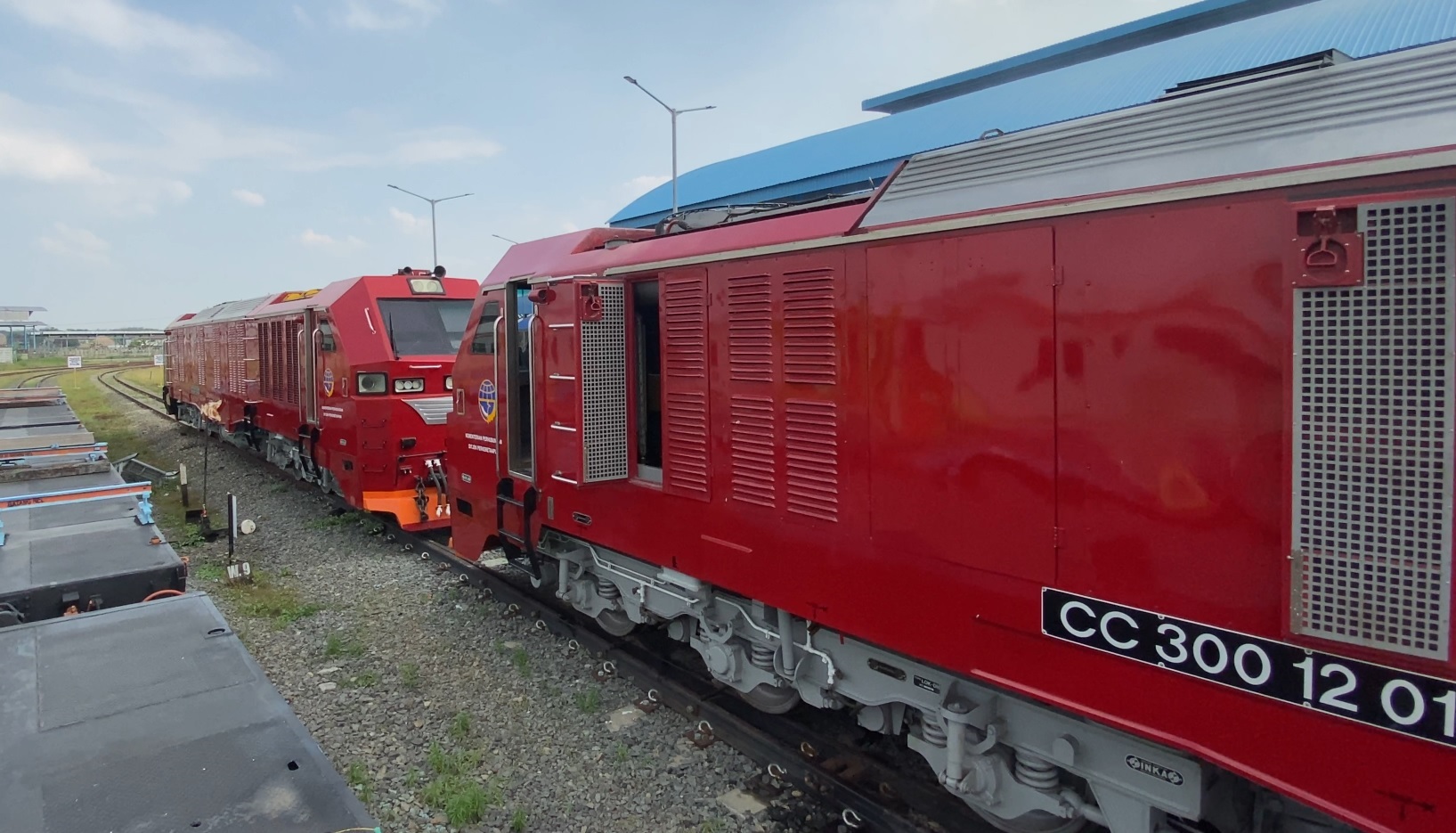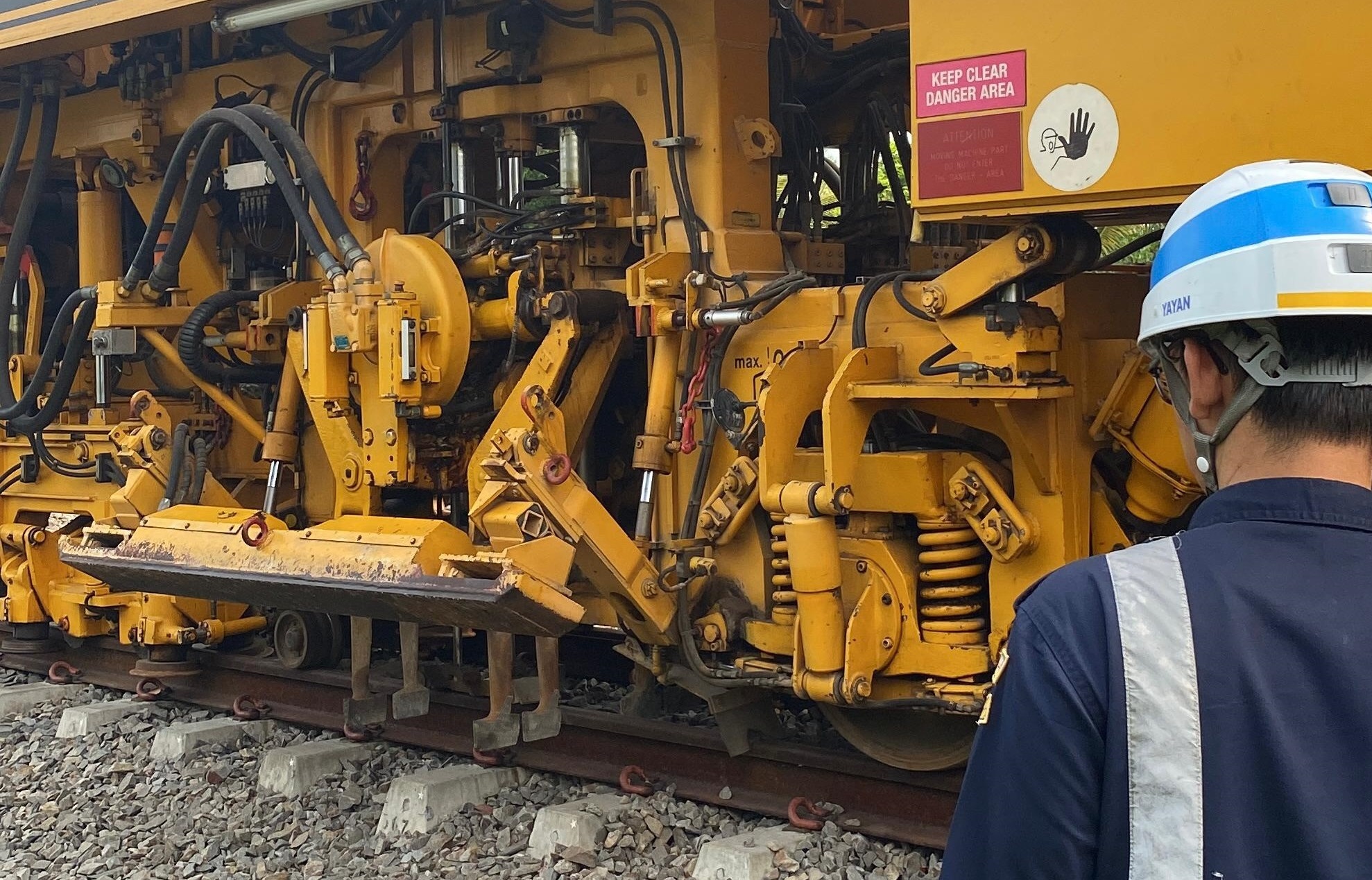Maintenance of the CC 300 Locomotive P12

Grobogan – Two government-owned CC 300 locomotives in the Ngrombo Workshop are undergoing P12 maintenance which falls in June 2023. The locomotives are managed by the Railway Maintenance Center, Directorate General of Railways, Ministry of Transportation.
It should be noted that referring to the Regulation of the Minister of Transportation of the Republic of Indonesia Number: PM 54 of 2016 concerning Standard Specifications for the Identity of Railway Facilities, what is meant by a locomotive is a railway facility that has a self-propelled mover that moves and is used to pull and/or push trains, carriages, and / or special equipment.
As a locomotive currently being cared for by the Railway Maintenance Center, the CC 300 locomotive is produced by PT INKA (Persero) Madiun. All CC 300 locomotives total five units spread across various regions in Indonesia.
As of this writing, the distribution of the CC 300 locomotives includes the Medan area of North Sumatra with the stabling CC 300 14 01 facility number in the Balai Yasa Pulubrayan area, Lampung region with the CC 300 14 02 facility number stabling at the Tanjung Karang Locomotive Depot, DKI Jakarta area with facility number CC 300 12 03, and two are at the Ngrombo Workshop, Central Java Grobogan Railway Maintenance Center, with facility numbers CC 300 12 01 and CC 300 12 02.
In daily operations, to maintain the reliability and performance of the CC 300 Locomotive railway facilities, the Railway Facilities Maintenance Team at the Railway Maintenance Office has carried out various locomotive maintenance activities on a regular basis.
Locomotive maintenance that is carried out includes daily, monthly, six-monthly and twelve-monthly or yearly maintenance.
One of the maintenances for the CC 300 Locomotive that was recently carried out at the Ngrombo Workshop is the twelve monthly maintenance, or what is commonly referred to as P12. Right in June 2023 all government-owned CC 300 locomotives managed by the Railway Maintenance Center entered the twelve-month maintenance period (P12).
Maintenance activities are carried out in a marathon, starting with the CC 300 Locomotive which takes place at the Ngrombo Workshop at the Railway Maintenance Center, then continues in turns for the CC 300 Locomotive which takes place at the Cipinang Train Depot, Balai Yasa Pulubrayan, and CC 300 Locomotive which takes place at the Tanjung Karang Locomotive Depot .
The maintenance process for the CC 300 Locomotive which took place at the Ngrombo Workshop at the Railway Maintenance Center was carried out for several days. The maintenance work began on Monday (12/6/2023).Grobogan – Dua Lokomotif CC 300 milik pemerintah yang berada di Workshop Ngrombo masuk perawatan P12 yang jatuh pada bulan Juni 2023. Lokomotif tersebut dikelola oleh Balai Perawatan Perkeretaapian Direktorat Jenderal Perkeretaapian Kementerian Perhubungan.
The P12 maintenance was carried out in the area outside the Ngrombo Workshop Building at the Railway Maintenance Center. Located on the fifth railroad track, right on the east side of the Ngrombo Workshop Building. The selection of the treatment point considers the ease of implementing the P12 treatment process. The maintenance task of the CC 300 Locomotive P12 involves a Maintenance Team managed by the Railway Maintenance Office.
The Maintenance Team performs maintenance tasks according to established procedures. So that the quality of the maintenance carried out really pays attention to the durability of the use of the railroad facilities in the future.
To note, the CC 300 Locomotive is a type of locomotive that has a vital role in railroad public transportation services. This locomotive has a kitchen runway with hydraulic diesel engine specifications. The use of this type of engine provides its own advantages, which makes the CC 300 Locomotive have resilience when asked to drive over a waterlogged rail track.
Such as when high rain intensity hit the city of Semarang in early 2023. This weather was the cause of the floods that hit several points of railroad crossings for long-distance rail lines. As a result, PT KAI (Persero)'s locomotives carrying passenger trains from Jakarta to the east and vice versa stopped temporarily, because they were unable to cross the puddles on the flood-affected rail lines.
It was at that time, the CC 300 Locomotive was dispatched to evacuate the carriages and passenger trains across the flooded puddles on the railroad crossings. So when viewed from its role, the CC 300 Locomotive can be said to be present during an emergency situation, in order to expedite the flow of public transportation in the railway sector, and ultimately to provide services and benefits to the people who use rail transportation.
Seeing this vital role, maintenance of the CC 300 Locomotive is carried out seriously, according to the correct procedure.
In addition to carrying out maintenance tasks, the Railway Maintenance Center also carries out an educational role for SMK students who take part in PKL (Field Work Practice) activities. The P12 activity was also used to introduce locomotive maintenance methods to PKL students, while still paying attention to the K3 (Occupational Health and Safety) aspect.
As part of the maintenance procedures for railway facilities, activities start with preparing maintenance support tools, spare parts and consumable parts needed. Apart from that, other tools are also prepared to be used in measuring and inspecting railway facilities.
Implementation of maintenance begins with oil changes, including engine oil, transmission oil, axle oil, bearing block oil, and generator oil. In addition, it is necessary to replace filters including fuel filters, water separator filters, oil filters, and coolant filters.
In the twelve monthly maintenance, not only is P12 carried out, but the Care Team also performs daily and monthly maintenance activities. This includes checking all parts of the CC 300 Locomotive facility, from the upper frame to the lower frame according to the twelfth monthly maintenance checksheet (P12).
As an illustration, these inspections include checking the motto lights, spotlights, battery voltage, temperature inside the cabin, checking the radiator, checking the engine and generator, recording cabin indicators, cleaning the cabin, measuring the height of the coupler, measuring the wheel diameter, measuring the wheel profile. , checking the braking function, checking the primary and secondary springs, checking the bogies, checking the cardan shaft and traction rod, carrying out static tests and dynamic tests, and others.
At the end of the P12 maintenance activities, after the entire series of maintenance has been completed, the entire CC 300 Locomotive body will be washed to maintain the quality of the CC 300 Locomotive paint and outer protection. (yogo)



.jpg)

Komentar
LOGIN FOR COMMENT Sign in with Google